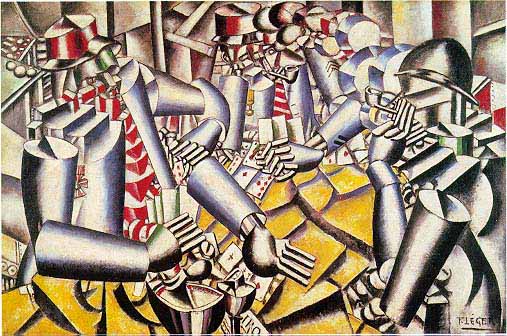| III | |
|
Who
Put the Hype
Leger: Card Game |
Cue
sound three.
Cue visual four Sound
three:
Well,
I'm really not such a bad guy
once
you get to know me.
Visual
four . . .
Your
life's a dime-store novel.
This
town is full of guys like you.
Could we call emerging experimental styles in exposition a cubist genre of (academic) prose? Some literary critics refer to Virginia Woolf's prose as cubist because of the way she disrupts and/or develops her narrative by juxtaposing scenes temporally out of sequence or by presenting the same subject from multiple perspectives. Flashbacks and jump cuts, schizophrenic sensibilities, and characters outliving themselves would seem to the late Victorian narrative a passable analog to what Picasso and Duchamp were to the visual art of the world grown accustomed to Monet. The current multivoiced, multiform textualities appropriate the fragmented rationality from the intellectual culture of our day to re-present it in the development of the essay. It owes something perhaps to electronic hypertext, something to experiments in print genres (Woolf is a predecessor in this regard). In its tolerance for nonlinear associations, it resonates even with the discourse of much older traditions. Navajo thought, according to Toelken, honors a "cluster logic," by which events are related because they cluster around an evident theme. What Anglos might call mere coincidences-no linear cause and effect-are seen as self-evident, meaningful associations. It also owes something to the videographic influences around us. Cue visual five. Is this a newly
visual form, a visual revision of the essay? In the visual revision, is
there also an intellectual and aesthetic revisioning?
|
